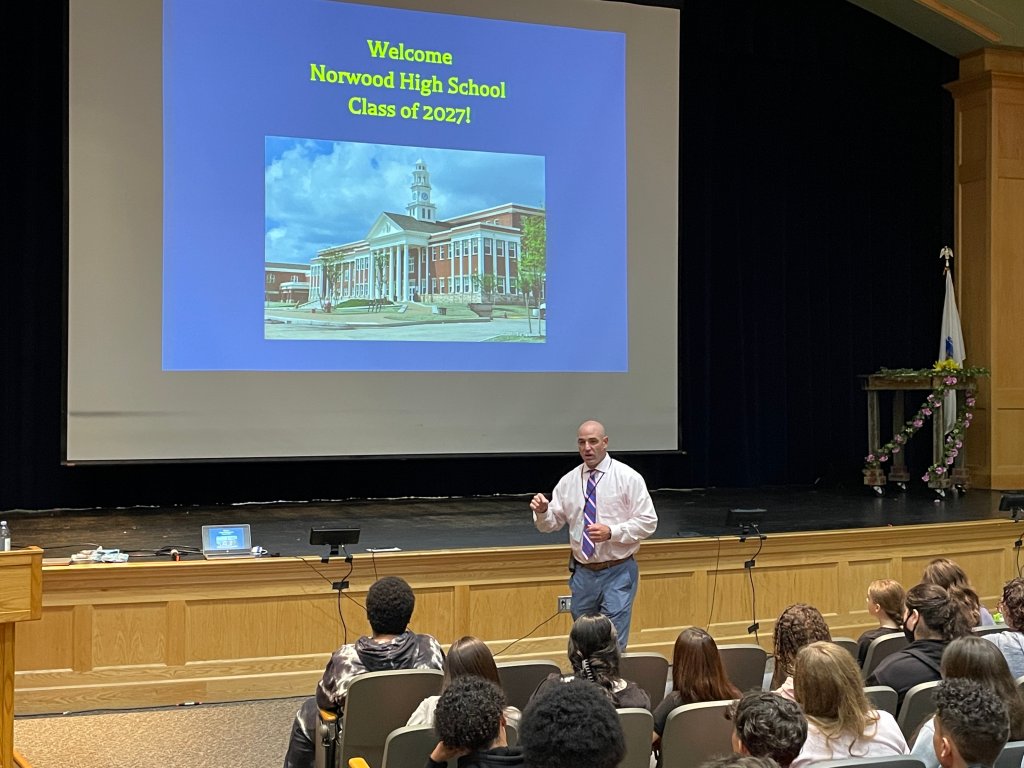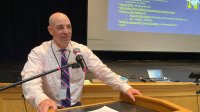A School Leader’s Approach to Career Education
Career development education has many benefits but can be hard to implement. See how one high school principal is making it work.
Your content has been saved!
Go to My Saved Content.Career and technical education is a powerful way to teach students about the “why” behind their learning. It often goes beyond the school building through collaborations with local or regional partners so that students work in the fields that will be open to them in their area upon graduation. This approach can build students’ confidence, sense of future, and communication skills, as well as foster multigenerational connections across a community.
Implementing an educational philosophy like this requires the commitment and oversight of a dedicated school leader, and to find out about this work, I talked to Hugh Galligan, a Massachusetts educator for 17 years who started as an English teacher and has been principal at Norwood High School since 2018. With a passion for systems-level thinking, Galligan—the 2022–23 Massachusetts Principal of the Year—oversees career preparation, internships, and work-for-credit programs that connect students and teachers with businesses and universities. The career development education (CDE) program at Norwood allows students to obtain college credit and medical certification, and it connects out-of-school work with students’ educational advancement.
Galligan shared with me a few insights on implementing CDE programming.
BRITTANY COLLINS: As a principal, how do you guide your staff to work toward a school-wide goal like career development education?
HUGH GALLIGAN: In my first year as principal, we set out to create a portrait of a graduate. We had a large committee of community members, staff, students, and families come together to figure out what essential skills our students needed. We determined our “five Cs”: creativity, collaboration, critical thinking, citizenship, and communication.
We [already had] a long-standing mission to achieve excellence in the “four As”: academics, arts, athletics, and activities. We packaged our mission, vision, and portrait of a graduate to say: “Four As, Five Cs, One Team.” It’s helpful to have that mantra, to remember that none of these things stand alone.
COLLINS: How can a principal turn a mantra like that into a plan for daily work for a large staff?
GALLIGAN: I was fortunate to walk into a school that valued that mission and understood that, while academics are our primary goal, there are so many elements that make up a well-rounded education, create positive experiences, and influence academics. Connections to arts, athletics, and activities are often how students feel a sense of belonging or connection to their school.
Everything we do has to align with the mantra, from school to district strategic goals. We flesh it out at the classroom level and have content teams work together to say, in a ninth-grade biology class, what does proficient communication look like? What does successful collaboration look like in U.S. History?
Each department works together to take the five essential skills [and match them with] the nitty gritty of each content area, grade level, and class. Everything is united under that portrait of a graduate.

COLLINS: And those essential skills and your portrait of a graduate are integrated into your career preparation program?
GALLIGAN: Yes. These goals have been in place for five years. Each year we look at our career preparation for our students and integrate that into our programs of study. We’re the only high school in our town, and we have in our region a multitude of partners. We found that there was a gap in the kind of coursework we were offering, the interests of our students, and the demands of our workforce.
We set out to develop career pathways that fill that gap. One example is the development of our health-care pathway—that was our first, flagship model that we started. The Department of Elementary and Secondary Education [DESE] in Massachusetts has a program called Innovation Pathways that recognizes that [many schools may lack] the ability or funding for large-scale career and technical programs. We were fortunate to be recognized by the DESE to be an Innovation Pathway school.
This is our fourth year with the health-care program, and we have 100 students, so about 10 percent of our population enrolled. Those students take college preparatory courses through dual-enrollment with university partners, participate in a 100-hour capstone or internship experience, and attain industry-recognized credentials, whether OSHA [Occupational Safety and Health Administration] certification, first aid, AED [automated external defibrillators], or CPR.
We want to make these programs available to any student, but particularly students from traditionally marginalized populations who might not otherwise have access. We have a really strong partnership with Harvard Medical School. Our students go there a number of times each year and conduct medical simulations; we’ve been able to develop a medical simulation lab here [with] two medical simulation dolls.
Next we’re developing an information-sector career pathway and a business and finance career pathway.
COLLINS: Those sound like meaningful opportunities. Can you tell me about the work that went into establishing this programming?
GALLIGAN: We did a year-long study of our daily schedule, and that encompassed a lot more than the time and order of classes. It centered around student voice and choice, and [provided students with] options to experiment with different interests and then move into specialization in their later years.
Students interested in introductory computer science would, under our previous model, have had to take that as a full-year course. The changes we made opened up more options for younger students to experiment with different electives. Junior and senior electives become full-year; keeping in line with our career pathways, students can follow a certain [elective] sequence that aligns with their interests.
We also freed up time for students to participate in work-based learning during the school day. We wanted to make sure that, if a student is working a significant amount of hours—which many of our students do to support their families—or wants to participate in an internship, they can. We moved from a seven-day rotation to only rotating some classes. Maybe a student is working 30 hours a week in the restaurant industry in town; their manager can share feedback with our advisor at school and fill out timesheets, and the student can fill out reflections and get credit.
We also developed an internship program. For the first half of the year, students develop work-based readiness skills and identify potential fields. In the second half of the year, they’re out in the field during the last period of the day, typically a couple times a week.
COLLINS: The work you led on the portrait of a graduate required a lot of collaboration. How do you incorporate various community voices into your work?
GALLIGAN: It’s important to have stakeholders involved. But there are phases in which [certain] voices might need to be elevated or centered at different times. I’ve found that the launch of a project benefits from an interested, broad group of staff. Then you can ask: Who do we bring in here? How do we leverage student voice? How do we leverage our families, get their feedback?
It’s important to ensure that the direction and goal and intention of the work are clearly articulated so people know exactly what they’re giving feedback on. We want to make sure that, when we’re asking for feedback—doing a student focus group or family survey—the questions are directly related to what we need to find out, and participants know we value their time and voice.
COLLINS: What’s next for you?
GALLIGAN: I just started looking at intensifying supports for first-year students, whether they’re entering ninth grade or transferring. What are those students’ needs in that transition? How do we provide more of the right thing?
We’re mirroring the process we went through with our schedule study—starting with staff, then incorporating other stakeholders to get more information about structures we can put in place to better meet students’ academic, emotional, and behavioral needs.
We want to trust the process and not say we intend to arrive at a given outcome. We want it to be a genuine process and find out together—it’s really important to learn from those around you.
